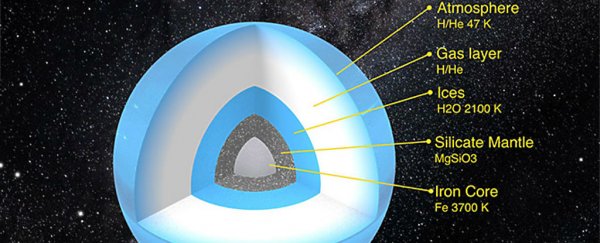Back in January, 'Pluto killing' astronomer Mike Brown announced that he and his colleagues had found evidence that a massive, icy planet could be lurking on the edge of the Solar System, just past Neptune, about 149 billion km from the Sun.
No one's ever seen it (being 75 times more distant than Pluto doesn't help), but Brown's estimated that the hypothetical ' Planet Nine' orbits our Sun every 10,000 to 20,000 years, and is about 10 times more massive than Earth and four times the size.
Now, Swiss astronomers have used the available data surrounding Planet Nine to figure out what the upper and lower limits on how big, bright, and warm it could actually be. The evidence suggests it's like a 'mini-Uranus', with a solid iron core surrounded in ice and a dense layer of gas.
"With our study, candidate Planet 9 is now more than a simple point mass, it takes shape having physical properties," says one of the team, Christoph Mordasini from the University of Bern.
Mordasini and PhD student Esther Linder decided to try and nail down some specifics for Planet Nine by applying the evidence surrounding Planet Nine to existing planetary evolution models. Not only does this allow them to make estimates on various characteristics of the mystery planet, but it also could explain about why after hundreds of years of getting to know the Solar System, we've only recently seen hints of its existence.
Based on the fact that our strongest evidence for the existence of Planet Nine is the weird behaviour of some Kuiper Belt Objects out on the edge of the Solar System - which suggests the gravitational pull of something massive is messing with them - Mordasini and Linder agree with previous estimates that it's likely no smaller than around 10 times more massive than Earth.
But the fact that multiple infrared surveys, such as NASA's Wide-field Infrared Survey Explorer (WISE) mission, have seen no signs of it means it can't be much bigger than 10 times more massive than Earth. And knowing its approximate distance from the Sun (based on where the weird Kuiper Belt Objects are) too, they could extrapolate a whole lot more.
"By their reckoning, Planet Nine should have a radius 3.7 times that of Earth and an upper atmosphere temperature of -226 degrees Celsius (or 47 Kelvin)," Ian O'Neill reports for Discovery News. "They arrived at these numbers by considering Planet Nine's predicted orbit around the Sun and the age of our Solar System; the hypothetical world would have formed from our Sun's protoplanetary disk that began to condense into planets some 4.6 billion years ago."
Interestingly, the models showed that at that distance from the Sun, Planet Nine should be a lot colder if our star is its only source of heat.
Having an estimate for its temperature means they were then able to figure out how bright it could be. As O'Neill explains, when planets form, the incredible amount of gravitational energy generated in their cores can keep them molten hot for billions of years, and this heat could contribute to the overall temperature of the planet.
So to maintain a temperature of -226 degrees Celsius some 149 billion km from the Sun, the researchers suggest that Planet Nine's 'intrinsic' - or internal - power is about 1,000 times bigger than its absorbed power.
"This means that the reflected sunlight would be minuscule compared to the internal heat the world is currently generating, making its infrared signal vastly more powerful than looking for reflected sunlight in optical wavelengths," says O'Neill.
Of all the radiation that could be detected around Planet Nine, sunlight makes up only a tiny part of that, and - if it exists - it should be much brighter in the infrared wavelengths than in the visual wavelengths.
The team has also come up with estimates of what the planet could be made of, which you can see in the graphic above.
So… why haven't we found it yet? Mordasini and Linder suggest that the sky surveys that have been performed in the past were very unlikely to have detected anything in the Solar System with a mass equivalent to 20 Earth masses or less, especially if they were looking when the planet was near its farthest point from the Sun.
But there is hope - future telescopes such as the Large Synoptic Survey Telescope, which is currently under construction in Chile, should be powerful enough to spot something smaller, or more focused surveys might be able to turn up more evidence that something really is out there.
We have to be patient for either of those possibilities, but one thing's for sure - answers are coming, and we can't wait to find out what they are.
The study has been published in Astronomy & Astrophysics.
